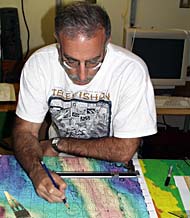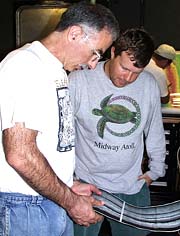|
|
Interviews: Mike Perfit
Question:
Have you been on lots of research cruises? Do you like it? Mike: Yes. Being in the field, whether it is on land climbing up a volcano, or at sea dredging up rocks, or diving in Alvin and seeing them first hand and collecting them with Alvin’s claw, is what I like best about my work. I have been on a few dozen research cruises, many of them with the people on this cruise, Dan and Rachel in particular. Dan and I have been on about 10 expeditions together over the past 20 years. A lot of my work involves sampling rocks from the seafloor. When I get back to my lab, I analyze them to determine their chemical composition, how they came from the Earth’s mantle, and what chemical changes they have gone through. It is amazing to me that I can learn from rocks about ancient events that took place long before there were people on Earth to watch them happen, or learn about things that happen within the Earth hundreds of kilometers down in places where no human can see (like inside a magma chamber!). This is the puzzle-solving part of science and what makes it so much fun. Question: What are you responsible for doing on this cruise? Mike: I am one of three watch leaders (Maya and Rachel are the other two), so I have to oversee what all of the students are doing as we collect data. I have to make sure the data are good, that the navigation on each watch is kept up to date and that we are towing the sonar system at the right altitude and over the points on the map that Dan Fornari has picked for us to survey. I make sure all the interpretations the students are making and entering into the computers in the Control Van are correct. Finally, and what is the most fun, is exploring and just finding new lava flows, watching the sonar data show us the volcanic terrain under the ship. Looking at the DSL-120 sonar data is just like being in an airplane at about 10,000 feet flying over the East Rift Zone of Kilauea Volcano in Hawaii; seeing fissures, faults, volcanic cones, and lava flows all intertwined and trying to sort out the puzzle of what it means and how they formed. But standing watch is pretty intense, so it is important to take a little time and let your brain relax by going outside and watching the ocean, reading, exercising, or dueling with an evil caterpillar in a computer game (which I tried the other night- it was pretty neat!). The other main responsibility I have on this cruise is to work with Dan and Maya to decide where we want to collect samples of the lava flows that we image with the DSL-120 sonar and Argo II systems. We will be scooping up seafloor lava using dredges which are big steel chain bags that bash along the bottom and collect rocks. Dredging is lots of fun, except when you get the dredge hung up and it gets stuck to the bottom. It is not fun being anchored to the ocean floor; sometimes it can take hours or even days to get unstuck. We will also use a rock corer to sample lava. A rock corer is basically a large, heavy steel dart that bashes into the lava flows and collects chips of the volcanic glass in wax. We actually use a type of surfboard wax that comes from California on the tip of the corer that slams into the seafloor. The wax has just the right stickiness to keep the glass chips embedded in it as they are hauled back to the surface. Because there are so few rock samples that have been collected from the East Pacific Rise axis in the area between 1°N and 8°N latitude where we are looking for new eruptions, every rock we find will tell us something new about the chemistry of the magma that produces lava on the seafloor and the processes going on in the Earth’s mantle. Don't get me started on talking about geochemistry or I’ll miss my watch!
What do you like most about your job and being at sea? Mike: I think, first and foremost, I like to be outside, exploring and using my brain to solve science puzzles. There aren’t many jobs where you get paid to do all the things that you like to do - be in the outdoors, travel to exotic places, go out to sea and make discoveries. Also, I like teaching a lot. I think the combination of doing two really different things - teaching and research- is good, it keeps you on your toes. A big part of scientific research is done totally on your own, interpreting your own ideas and evaluating what other scientists are doing - synthesizing information. You use this in your own research, but you also have to distill it down to where students can understand it and get excited about the science - that is often a real challenge but also a lot of fun. Question: It sounds like you love everything about what you do. Is there anything you don’t like about your job? Mike: Well, I don’t like how much I have to do sometimes, especially the non-science parts of my job. Being a college professor, you are expected to be an administrator, a bureaucrat, a committee member, a teacher, a researcher; each one of those jobs takes half of your time - you can see that it adds up to too many full-time jobs. Another thing I find frustrating about how much we have to do as scientists is that sometimes you feel that you can’t get everything done as well as you would like to. We are trained to be perfectionists... to do good experiments, carefully, record the data and analyze it correctly. When you start applying those same criteria to the administrative and non-science parts of the job you can get frazzled quickly and sometimes it takes time away from your family. That is not good. But, despite all of the frustrations (and all jobs have things that are not fun to do), being a scientist gives you lots of freedom. You are your own boss, so you work at your own rate, doing whatever you think needs to be done. Sometimes, though, you can be your own worst boss, always pushing yourself to do too much. Question: Do you ever get seasick? Mike: Yes., though fortunately the weather on this cruise has been terrific so I’ve felt fine. Over the years I’ve gotten better and better about how prone I am to seasickness. My first few times at sea I was “hanging off the rail feeding the fish” as they call it, quite a lot. And then 4 or 5 years ago I seemed to have reached some type of plateau where the rocking motion didn’t bother me as much. But when it gets rough and the ship really starts to pitch, and you feel like there is no gravity, I don't care how much of an old salt you are, most folks feel the effects of a rough sea and get sick; it's miserable. But, despite the rolling around, where else can you go out and see all the wonderful creatures that live in the ocean every day, and each evening see a sky full of bright stars, AND get to actually see and make discoveries about the bottom of the ocean.
|
||||||
|
|
|||||||
© 2010 Dive and Discover™. Dive and Discover™ is a registered trademark of
Woods
Hole Oceanographic Institution



